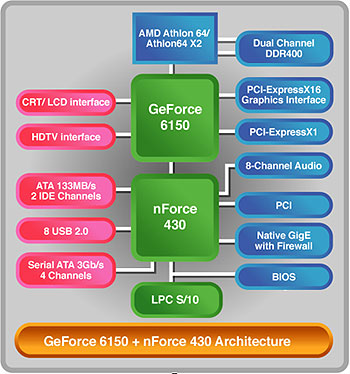The nVidia GeForce 6150 chipset allows AMD users something they have
very badly needed, a low cost fully integrated solution. The GeForce 6150-series
'C51' GPUs are built on TSMC's 90 nanometer manufacturing process, and are
intended to support current Socket 939 AMD Athlon64 processors.
Memory support is actually up to the memory controller built into the
Athlon64 processor, but from what we have seen so far most GeForce 6150-series
motherboards will have four DDR DIMM slots, which means up to 4GB of PC3200 DDR
RAM can be used. The GeForce 6150-series chipset is connected to the Athlon64
processor via a 1 GHz 16/16 p/Down Hypertransport connection (which is
adjustable in the BIOS).

The GeForce 6150 supports a TV encoder, TMDS/DVI
support, a slightly higher graphics core speed (475 MHz as opposed to 425 MHz
for the 6100), 18 total PCI Express lanes (16 for the videocard, two for misc
devices), 1080p/1080i HD playback and higher video scaling. The GeForce 6100 on
the other hand does not support TV encoding or TMDS/DVI output, and only sports
standard definition (4:3) video playback. The nVidia GeForce 6150 series is not
a single chipset solution, and so it is combined with the nforce 430 or 410
Southbridge. Both Southbridge chipsets are Serial ATA II compatible, however the
nForce 430 supports RAID modes 0, 1, 0+1 and 5. The nForce 430 series chipsets are also compatible
with Intel's new Azalia 7.1 channel high definition audio codec. Connecting the motherboard chipsets is another
HyperTransport connection; this however only runs at 800 MHz with an 8
bit wide Up/Down data bus.
Component output (Y, Pb, Pr) support is vendor specific,
and in the case of the Gigabyte GV-K8N51PVMT-9 accessed via a break-out box
which connects to the rear I/O adjacent to the analog video
connector. The GeForce 6150 series graphics cards has two pixel rendering
pipelines so that right away should tell users the onboard graphics card is best only for casual
gaming. It does however support the DirectX 9.0C standard as well as support for Shader Model
3.0, so the onboard videocard will work just fine with Microsoft's Vista upcoming
3D desktop.
|
experts tip: less memory for onboard
video |
|
the geforce 6150 demands 64mb of system memory to use as its own frame buffer.
if you do not play games, it is a good idea cut down the amount of
memory it requires, freeing it up for the system. to do this, enter the bios (by
pressing the "Del" key when the computer first boots up) and enter the "Advanced BIOS
Features" section. From there find the "Frame Buffer Size" controls and lower
the amount of memory used to 16MB. The default value is 64MB, but 16MB is
plenty for desk tops resolutions up to 1280x1024. The extra memory will be available once
more for the system, and should help improve overall performance. |
| Comments and Feedback? Suggest a
Tweak. |
Another nice feature is that the onboard graphics card is not automatically
disabled when using a PCI Express x16 graphics card. Users who need a lot of
desktop screen real estate will certainly appreciate that feature.
